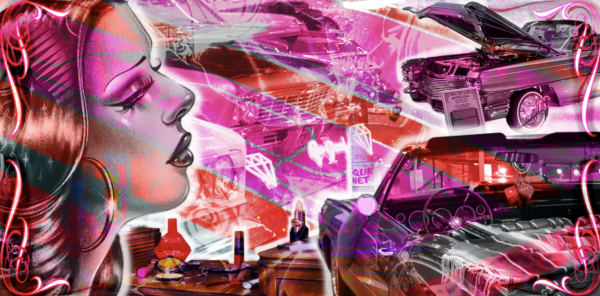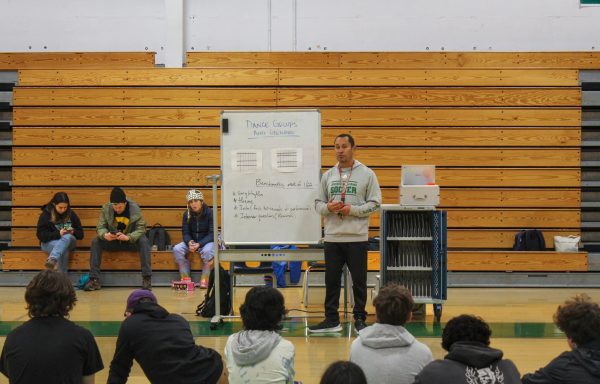An in-depth look at the lives and experiences of female firefighters in Northern California
2001 SNOWBOUND, ALL RIGHTS RESERVED
Fire Captain Jenn Panko with her friends from the academy (back row from left to right: David Hoos, Jenn Panko, JD Madden; front row from left to right: Lucy Clark, Aurelio Perez, Doug Christain) when they got hired in 1997.
Roughly 4% of American career firefighters are women, according to the National Fire Protection Association (NFPA). While the fire service is male-dominated, many women across Northern California are working hard to show that gender does not define capability.
As many know, a career in fire is difficult. Most stations in the Bay Area work the “48-4” schedule- 48 hours of training and responding to calls at the station and four days at home to see family and friends. Crews of three to five firefighters work on an alternating shift schedule to ensure that there are people at the station at all times.
The best part about the job is when somebody comes up and thanks you. I’ve always loved helping other people, no matter what capacity.
— -Elaney Karabetsos, Firefighter/Paramedic for Novato Fire Department
At the Santa Clara Fire Department, for example, there are always three to four people at the station. Crew members have various ranks of Captain, Driver Engineer, and Firefighter, with every member also being an Emergency Medical Technician (EMT). There is always at least one crew member who is also a paramedic.
Although the job is strenuous, most firefighters have a strong passion and love for their career and their fellow crew members. The close-knit crews spend 48 hours together at the station. They eat, sleep, train, and relax with each other when they’re not responding to calls.
“I love everything about my job…We do anything and everything we can to protect you guys, and civilians and the public, and each other,” said Novato Firefighter/Paramedic Elaney Karabetsos.
Statistically, the fire service is a male-dominated career. According to Santa Clara Fire Captain Jenn Panko, having at least one woman on a crew is uncommon.
“It’s usually rare for there to be two women in one station. It does happen on occasion, but for the most part, you’re usually the only woman on your crew, or your shift, or maybe even in your department,” Panko said.
American firefighters have had a prominent role in our nation’s history. Fire prevention can be traced back to the 15th century in America, but careers in the fire service were only open to men. The first known female career firefighter, Judith Livers, was hired by Arlington County Fire Department in 1974.
Novato Firefighter/Paramedic Nicole Scott sees this tradition as a difficult obstacle to overcome for female firefighters.
“For so long, Firefighting has been a male dominated field. It has taken a very long time for women to break through that barrier, and it’s still a work in progress for some departments throughout this country. Real change and acceptance takes time,” Scott said.
I believe that I work harder than most of my male colleagues, because I want to be respected, and respect isn’t something you can regulate…I have to work harder for the same respect [that a man has]. — San Francisco Female Firefighter
A female firefighter from the San Francisco Fire Department who lives in Marin County also experiences gender disparities between men and women in fire. She wants to remain anonymous in fear of possible backlash at her work from her involvement in this article.
“I believe that I work harder than most of my male colleagues, because I want to be respected, and respect isn’t something you can regulate…I have to work harder for the same respect [that a man has],”she said.
For many women in fire, this is extremely frustrating. While not all men in the fire service view women as outsiders, there are still plenty of male individuals that treat women as inferior. The anonymous source recalls an experience in which she visited a station and was ignored by the all-male crew on duty.
“At some of the ‘worst’ stations, where there’s never any women and it’s really extremely masculine-competive, I might go to that station and everyone will refuse to talk to me. I’ll come in and say ‘Good morning,’ and no one says good morning. And I’ll grab a pot of coffee and say ‘Hey, anyone want more coffee?’… and they’ll just look away and not answer,” Anonymous said.
Even though it’s a tough battle against sexist traditions in the fire service, most female firefighters love their job and wouldn’t choose any other career path. This being said, the job takes an extraordinary amount of both emotional and physical strength.
All firefighters see tragedy on a daily basis. According to Panko, recovering mentally from tragic calls is extremely difficult.
“[A call] that I could share with you is a young child whose mother actually decided to take her own life, and she did so by laying on the train tracks…she had her young son with her, who was only three years old,” Panko said. She remembers the mother was killed, but the son survived with an amputated leg.
“…that stands out to me as a call that impacted me greatly,” Panko said, “It was very traumatic to see this poor child and what he was going through and how it was going to affect him the rest of his life.”
These types of calls require resources for emotional and mental recovery, and the fire service has only recently realized that. According to Scott, who is also the head of the Novato Fire Peer Support Program, the culture of the fire service for many years was that firefighters would cope with mental stress on their own.
“[Mental health is] kind of my big passion besides actually being a firefighter, letting firefighters know that it’s okay to not be okay. It’s okay to have a hard time after calls or not being able to fall back asleep. Our culture in the fire service for years has been you keep everything inside, you don’t show your emotions, you don’t talk about your feelings…we’re finally catching on that hey, this job is hard, and it’s okay to talk about it,” Scott said.
The long-standing culture of the fire service has been considered extremely emotionally suppressive. As a result, suicide and depression rates in fire are unproportionally higher than those of the general population.
“There’s all kinds of terrible stories of firefighters who didn’t really get help along the way, and who bottled it all up and kept it inside, and then after they retire they just sometimes go into a deep depression. Unfortunately there’s definitely high levels of suicide among firefighters, higher than the rest of the population,” said Panko, who is the Peer Support Team Coordinator of her department.
A wider variety of resources are being offered to firefighters that didn’t exist a few years ago. Peer resource groups, therapy, and wellness programs like FireFlex are available to help first responders stay mentally strong.
I would encourage women getting into this field. It’s amazing and you can do the job. Don’t let any [anyone] tell you that you can’t, because it’s just not true.
— Nicole Scott
For many in the fire service, it can be challenging to find a balance between dealing with trauma at work and having a personal life at home.
“The mental stress and the mental stuff we deal with on a daily basis with the stuff that we see, being able to vocalize that, or being able to deal with it, is kind of hard at times. You want to deal with it at work, because you don’t want to take it home to your family… A lot of the stuff we see and do our family doesn’t really need to hear about, because it can be intimidating or uncomfortable,” Karabetsos said.
Working in the fire service takes an extraordinary amount of mental and physical strength. For women in fire, the job is even harder considering the sexist traditions rooted deep in the fire culture. Even considering this, most female firefighters encourage girls to pursue careers in fire.
“I would encourage women getting into this field. It’s amazing and you can do the job. Don’t let any [anyone] tell you that you can’t, because it’s just not true,” Scott said.
Your donation will support the student journalists of Archie Williams High School. Your contribution will allow us to purchase equipment and cover our annual website hosting costs. Each donation will receive a magazine subscription for a year (6 copies a year), and become a part of the important work our publication is doing.
$35 -- Subscription to the magazine
$50 -- Silver Sponsorship
$75 -- Gold Sponsorship
$100 -- Platinum Sponsorship

Alice is a senior, starting her fourth year in journalism. She enjoys hanging out with her friends and her plants, and rewatching Parks and Recreation....















John Rosenberg (Ampa) • Oct 13, 2020 at 11:03 AM
What a wonderful article. Well researched and well written. Cudos to my granddaughter.